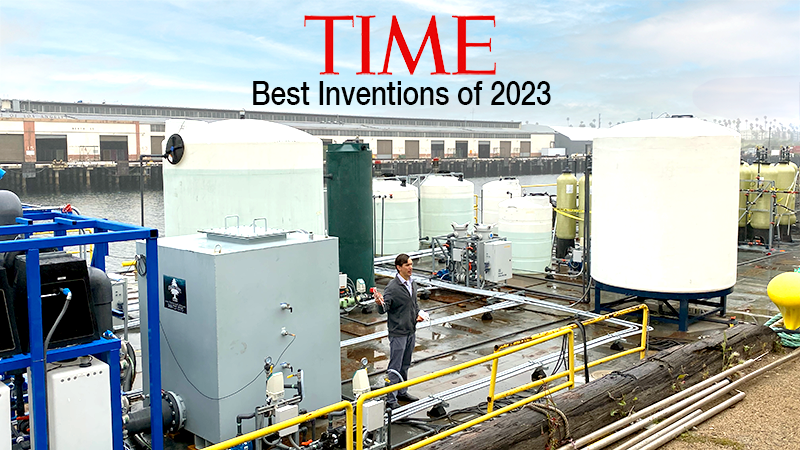Time Picks UCLA Engineering Climate Solution as One of 2023 Top Inventions

UCLA chemical and biomolecular engineering associate professor Dante Simonetti demonstrated the carbon removal and hydrogen production technology aboard the Equatic pilot system at the Port of Los Angeles in April 2023.
Time magazine has named the carbon-removal Equatic process developed at UCLA’s Institute for Carbon Management (ICM) one of the best inventions of 2023 in the sustainability category.
Formerly known as Project SeaChange, the Equatic technology was created by a team of researchers at the UCLA Samueli School of Engineering. The process accelerates and expands the ocean’s natural ability to absorb carbon dioxide (CO2) to remove atmospheric CO2, storing it in the forms of solid minerals and aqueous species for more than 10,000 years, while producing carbon-negative hydrogen — a clean fuel for transport and industrial applications.
In less than two years, the technique was scaled up from a bench-scale prototype into two pilot systems this spring in Los Angeles and Singapore, respectively. The startup Equatic was launched to commercialize the technology. One hundred percent of the carbon dioxide removed from these two pilots has been pre-sold to companies such as financial services company Stripe. In May, Equatic announced a pre-purchase option agreement to remove 62,000 metric tons of carbon dioxide and deliver 2,100 metric tons of carbon-negative hydrogen to The Boeing Company. Equatic expects to reach 100,000 metric tons of carbon removal per year by 2026 and millions of metric tons of carbon removal for less than $100 per metric ton by 2028.
“We are thrilled that Time has recognized the potential of our low-cost carbon removal and green hydrogen production technology as we work toward net zero by 2050,” said Equatic founder and ICM director Gaurav Sant, who is UCLA Samueli’s Pritzker Professor of Sustainability and holds faculty appointments at the departments of civil and environmental engineering and materials science and engineering. “The need for scalable and sustainable solutions to reduce and remove atmospheric carbon dioxide is more urgent than ever, and we are proud to lead the charge in developing innovative solutions.”
Civil and environmental engineering professor David Jassby, who is an associate director of ICM, is also a co-founder of Equatic and a co-inventor of the carbon-removal process.
In April, ICM unveiled its first Equatic pilot system at the Port of Los Angeles, drawing major media coverage by Forbes, Associated Press, Bloomberg, Los Angeles Times, CNN, among many others.
“We are thrilled that Time has recognized the potential of our low-cost carbon removal and green hydrogen production technology as we work toward net zero by 2050,” said Equatic founder and ICM director Gaurav Sant, who is UCLA Samueli’s Pritzker Professor of Sustainability. “The need for scalable and sustainable solutions to reduce and remove atmospheric carbon dioxide is more urgent than ever, and we are proud to lead the charge in developing innovative solutions.”
METHODOLOGY
- Seawater is passed between electrically charged electrodes, inducing a series of chemical reactions (electrolysis) that combine dissolved carbon dioxide in the water and CO2 in the air with existing calcium and magnesium (ions) in seawater to trap CO2 in the form of solid and dissolved calcium and magnesium-based materials, respectively.
- Carbon dioxide trapped in solid minerals and aqueous species is stable and durable for more than 10,000 years. Calcium carbonate, which makes up seashells, and magnesium carbonate species are naturally occurring and abundant in the oceans.
- The process chemically breaks down water into its hydrogen and oxygen constituents — producing green hydrogen gas as a co-product. The hydrogen can be used to power the process itself, or be used as a low-carbon energy source to power industrial processes and for transport and mobility applications.
- Equatic’s process allows on-site measurement of carbon dioxide removal before seawater is released back into the ocean ensuring that 4.6 kilograms (about 10 lbs.) of CO2 is removed per cubic meter (approximately 264 gallons) of seawater processed.
“Ocean water already contains 150 times more carbon dioxide than the air, and Equatic’s rinse-and-repeat flow-electrolysis process allows the oceans to serve as an enormous reservoir of CO2,” said Dante Simonetti, an associate professor of chemical and biomolecular engineering at UCLA Samueli and ICM’s associate director for technology translation. “This allows the approach to scale at globally relevant rates faster and cheaper than traditional direct air capture and related methods.”
Time’s annual list highlights game-changing innovations in multiple categories, including artificial intelligence, green energy and sustainability. Nominees are evaluated on a variety of criteria including originality, efficacy, ambition and impact. In 2020, a bedsore scanner invented by computer science distinguished professor Majid Sarrafzadeh of UCLA Samueli and his team was named one of the magazine’s top inventions.
The Equatic technology previously won first place in the 2021 Liveability Challenge global competition backed by Singapore-based nonprofit Temasek Foundation with 450 applicants from more than 60 countries. The research project has been funded by, among others, the Chan Zuckerberg Initiative, the Grantham Foundation for the Protection of the Environment, the Nicholas Endowment, Singapore’s Public Utilities Board, the Temasek Foundation and the U.S. Department of Energy’s Advanced Research Projects Agency-Energy (ARPA-E).
Founded in 2018, the Institute for Carbon Management takes a multidisciplinary approach to translate carbon dioxide sequestration and removal technologies rapidly from a university laboratory setting to pre-commercial or commercial-scale prototypes. This allows accelerated transformation of science-based technologies into scalable engineering solutions designed to make a real-world impact and bolster the global shift to a carbon-free economy. In April 2021, the institute’s CarbonBuilt project helped UCLA become the first university-led team to win an XPRIZE — $7.5 million grand prize — turning carbon dioxide into concrete.
